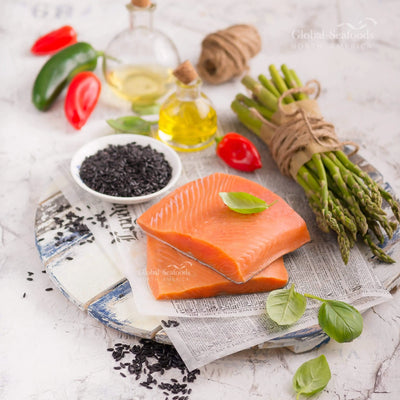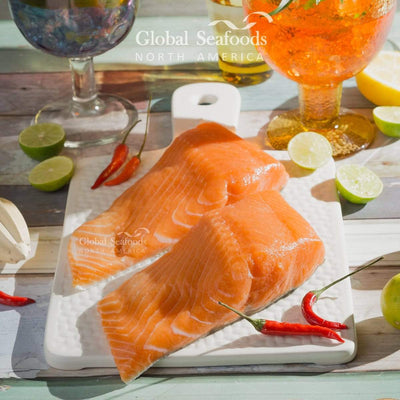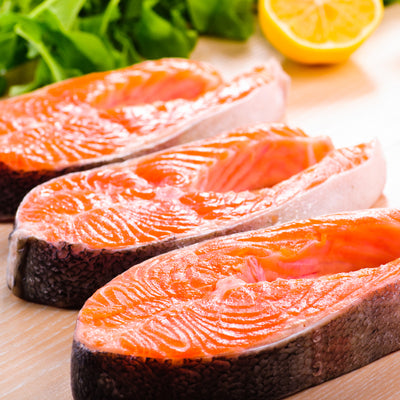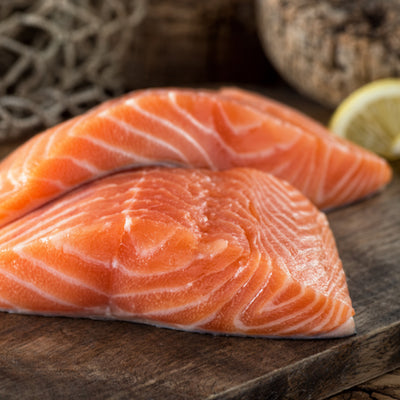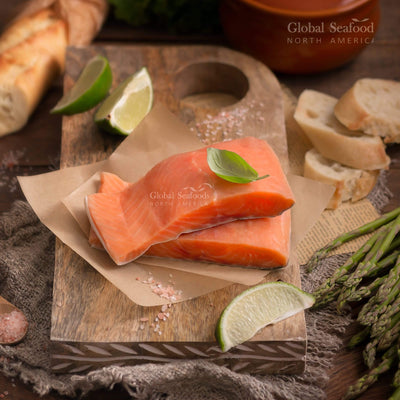+Shop Now
+Categories
- Abalone
- Ahi Tuna
- Alaskan King Crab Legs
- Alaskan Pollock
- Alaskan Sockeye Salmon
- Albacore Tuna
- Anchovy
- Anxiety Relief
- appetizer
- Atlantic Salmon
- Beluga Caviar
- Best Sushi
- black caviar
- black cod
- Blue crabs
- Bluefin Tuna
- Brain Function
- Branzino
- breakfast
- Calamari
- caviar
- Caviar Recipes
- Chef Knives
- Chilean Sea Bass
- Clams
- cocktail caviar
- Cod
- Coho Salmon Caviar
- collagen
- Cooking Methods
- crab
- Crab Balls
- Crab Cakes
- Crab claws
- crab meat
- Crab Recipes
- culinary tips
- decline-sturgeon
- Diver Scallops
- Dover Sole
- Dry Aged Fish
- Dungeness Crab
- Dungeness crab clusters
- Dungeness Crab Legs
- Exotic Shellfish Sampler
- Fish and Seafood
- fish oil
- Fish Sauce
- flat fish
- FLOUNDER FISH
- Focus
- Fresh Seafood Delivery
- Fresh Wild Alaskan Salmon
- Geoduck
- Gooseneck Barnacles
- Gourmet Seafood Platter
- haddock
- halibut
- Halibut Recipes
- hamachi
- Hamachi Recipe
- health
- healthy eating
- Ikura
- Japanese restaurants
- Jonah crab
- Jumbo Sea Scallops
- Kaluga Caviar
- kelp
- king crab
- King Crab Legs
- King Salmon
- kitchen
- Lingcod
- Live King Crab
- Live Lobsters for Sale
- Live Scallops
- Live seafood
- lobster
- Lobster Tail
- luxury food
- mahi mahi
- Marine Collagen
- Mollusk
- Monkfish
- Mussels
- New
- Nutrition
- octopus
- Opah
- Ora King Salmon
- Osetra Caviar
- Ossetra Sturgeon Caviar
- oysters
- Pacific Cod
- Pacific Hake
- Pacific Halibut
- Pacific Ocean
- Pacific Whiting
- Pacific Whiting Recipe
- Paddlefish Caviar
- Petite Oysters
- Petrale Sole
- Poke Tuna
- Pollock
- Pregnancy
- Premium Caviar Selection
- Recipe
- red caviar
- Red Crab
- rock fish
- Rockfish
- Rockfish Recipes
- sablefish
- Sablefish (Black Cod) Recipes
- salmon
- Salmon Caviar
- Salmon lox
- Salmon Poke
- Salmon Recipes
- salmon roe
- Sardines
- Sashimi
- Sashimi-Grade Tuna
- Scallop
- scallops
- Scallops Recipe
- Sea Urchi Recipe
- sea urchin
- Sea Urchin Sushi
- sea weed
- Seafood
- Seafood Dishes
- Seafood Market
- Seafood Recipe
- Seafood Restaurants
- sevruga caviar
- shellfish
- Shrimps & Prawns
- Silver Salmon
- Smoked
- Smoked Salmon
- Smoked Tuna
- Snail Caviar
- Snapper Recipe
- snow crab
- Sole & Flounder Recipes
- Squid
- Steelhead
- Sturgeon Caviar
- Sustainable Seafood Choices
- Swordfish
- Tilapia
- Tilapia Fish
- Tobiko
- Trout
- tuna
- Tuna Recipe
- weathervane scallops
- white fish
- White Sturgeon
- White Sturgeon Caviar
- Whiting Fish
- Wild Caught Shrimp
- Yellowfin Tuna
- Yellowtail snapper
Alaskan Salmon Fish – Stunning Colors & Culinary Artistry
February 22, 2025

Alaskan Salmon Fish – A Feast for the Eyes
When it comes to the mesmerizing world of aquatic life, few species captivate both nature lovers and food enthusiasts quite like the Alaskan salmon. Its stunning color variations, nutritional benefits, and culinary versatility make it a prized fish across the globe.
From vibrant pinks to deep oranges, salmon’s rich hues aren’t just aesthetically pleasing—they reveal the science behind pigmentation, diet, and habitat. In this guide, we’ll explore the spectacular color variations of Alaskan salmon, their nutritional impact, and why chefs adore this visually stunning fish.
🔗 Shop Wild-Caught Alaskan Salmon Here
Understanding the Spectrum: The Many Colors of Alaskan Salmon
Alaskan salmon come in a wide range of colors, from pale pinks to fiery oranges, with some rare exceptions. Their coloration is determined by species, diet, and habitat.
🔹 Chinook (King) Salmon: Usually deep red-orange, but an extremely rare white-fleshed variant (known as "Ivory King") exists due to a genetic trait preventing astaxanthin absorption. These white-fleshed King salmon are considered a luxury delicacy.
🔹 Sockeye Salmon: Has the most consistent deep red color due to a diet rich in krill and shrimp. Its meat maintains a uniform red hue, making it highly sought after.
🔹 Coho (Silver) Salmon: Similar to sockeye, coho salmon maintains a steady orange-red color throughout its life.
🔹 Pink Salmon: The color of pink salmon is graded from P0 to P4, with P0 indicating fish that are nearing spawning (almost translucent flesh) and P4 being the deepest pink.
🔹 Chum Salmon: Graded C1 to C3, with C1 being the most vibrant and desirable color. The chum salmon color grading system is widely used by seafood processors around the world.
🔹 Salmon Color Chart: The American Marketing Seafood Institute provides an industry-standard salmon color chart, which helps processors classify salmon based on color and quality.
🔗 Try Premium Sockeye Salmon Fillets
The Role of Diet and Habitat in Salmon Coloration
The phrase "you are what you eat" couldn’t be more true for salmon. Their diet and habitat directly impact their color intensity.
1. Wild vs. Farmed Salmon
- Wild Alaskan Salmon: Feed on a diverse diet in pristine waters, producing richer, deeper hues.
- Farmed Salmon: Often fed pellet-based food, which requires added pigments to replicate the natural color.
2. Water Quality & Oxygen Levels
- Pristine, well-oxygenated waters promote healthier fish with more vibrant pigmentation.
- Salmon in clear, cold Alaskan waters tend to have richer, more natural coloring.
🔗 Discover the Best Wild Alaskan King Salmon
The Visual Appeal of Culinary Artistry
Alaskan salmon isn’t just a treat for the taste buds—it’s also a showstopper on the plate.
Why Chefs Love Alaskan Salmon:
✔️ Vibrant Color Contrast – The rich hues of salmon contrast beautifully with green garnishes, citrus slices, and colorful sauces.
✔️ A Natural Work of Art – The deep orange and pink tones make each dish visually appealing and appetizing.
✔️ Versatile Presentation – Whether grilled, pan-seared, or sashimi-style, salmon’s natural color remains stunning.
🔗 Try Coho Salmon Fillet Portions
FAQs About Alaskan Salmon Coloration
1. Can the color of salmon vary within the same species?
Yes! Even within the same species, diet and habitat can lead to differences in color intensity.
2. Does cooking alter the color of salmon?
Yes, heat can denature astaxanthin, causing a slightly lighter shade after cooking.
3. Are salmon color variations purely aesthetic?
No! Brighter colors often indicate a richer diet and healthier habitat.
🔗 Learn More About Salmon & Caviar
Conclusion: A Kaleidoscope Beneath the Waves
The captivating colors of Alaskan salmon are a testament to nature’s artistry. From pale pinks to deep oranges, every shade tells a story of diet, environment, and health.
Next time you enjoy a succulent salmon dish, take a moment to admire the kaleidoscope of colors that nature has to offer.
🔗 Shop the Best Wild Alaskan Salmon Online:
👉 Sockeye Salmon
👉 King Salmon
👉 Coho Salmon
For more seafood insights and recipes, visit Global Seafoods on YouTube.
Related Products
Share:
Also in News

How to Make Sea Bream Sushi With Dry-Aged Tuna & Crab Roll — Step-by-Step With Chef Joshua
December 07, 2025
A complete guide to making Sea Bream sushi at home, including filleting, curing, slicing, and building a Dry-Aged Tuna & Crab sushi roll. Chef Joshua shares professional tips for restaurant-quality results.

Boiled Crab for Game Night: Everything You Need for a Perfect Seafood Party
June 27, 2025
Take your game night to the next level with a Boiled crab party. Learn the best recipes, cooking tips, and hosting hacks for a memorable seafood feast.

Boiled Crab for Date Night: A Romantic Guide to the Perfect Seafood Feast
June 27, 2025
Make your next date night unforgettable with a romantic Boiled crab experience. This guide covers everything you need to know, from ambiance to the best crab varieties.
+Shop Now
+Categories
- Abalone
- Ahi Tuna
- Alaskan King Crab Legs
- Alaskan Pollock
- Alaskan Sockeye Salmon
- Albacore Tuna
- Anchovy
- Anxiety Relief
- appetizer
- Atlantic Salmon
- Beluga Caviar
- Best Sushi
- black caviar
- black cod
- Blue crabs
- Bluefin Tuna
- Brain Function
- Branzino
- breakfast
- Calamari
- caviar
- Caviar Recipes
- Chef Knives
- Chilean Sea Bass
- Clams
- cocktail caviar
- Cod
- Coho Salmon Caviar
- collagen
- Cooking Methods
- crab
- Crab Balls
- Crab Cakes
- Crab claws
- crab meat
- Crab Recipes
- culinary tips
- decline-sturgeon
- Diver Scallops
- Dover Sole
- Dry Aged Fish
- Dungeness Crab
- Dungeness crab clusters
- Dungeness Crab Legs
- Exotic Shellfish Sampler
- Fish and Seafood
- fish oil
- Fish Sauce
- flat fish
- FLOUNDER FISH
- Focus
- Fresh Seafood Delivery
- Fresh Wild Alaskan Salmon
- Geoduck
- Gooseneck Barnacles
- Gourmet Seafood Platter
- haddock
- halibut
- Halibut Recipes
- hamachi
- Hamachi Recipe
- health
- healthy eating
- Ikura
- Japanese restaurants
- Jonah crab
- Jumbo Sea Scallops
- Kaluga Caviar
- kelp
- king crab
- King Crab Legs
- King Salmon
- kitchen
- Lingcod
- Live King Crab
- Live Lobsters for Sale
- Live Scallops
- Live seafood
- lobster
- Lobster Tail
- luxury food
- mahi mahi
- Marine Collagen
- Mollusk
- Monkfish
- Mussels
- New
- Nutrition
- octopus
- Opah
- Ora King Salmon
- Osetra Caviar
- Ossetra Sturgeon Caviar
- oysters
- Pacific Cod
- Pacific Hake
- Pacific Halibut
- Pacific Ocean
- Pacific Whiting
- Pacific Whiting Recipe
- Paddlefish Caviar
- Petite Oysters
- Petrale Sole
- Poke Tuna
- Pollock
- Pregnancy
- Premium Caviar Selection
- Recipe
- red caviar
- Red Crab
- rock fish
- Rockfish
- Rockfish Recipes
- sablefish
- Sablefish (Black Cod) Recipes
- salmon
- Salmon Caviar
- Salmon lox
- Salmon Poke
- Salmon Recipes
- salmon roe
- Sardines
- Sashimi
- Sashimi-Grade Tuna
- Scallop
- scallops
- Scallops Recipe
- Sea Urchi Recipe
- sea urchin
- Sea Urchin Sushi
- sea weed
- Seafood
- Seafood Dishes
- Seafood Market
- Seafood Recipe
- Seafood Restaurants
- sevruga caviar
- shellfish
- Shrimps & Prawns
- Silver Salmon
- Smoked
- Smoked Salmon
- Smoked Tuna
- Snail Caviar
- Snapper Recipe
- snow crab
- Sole & Flounder Recipes
- Squid
- Steelhead
- Sturgeon Caviar
- Sustainable Seafood Choices
- Swordfish
- Tilapia
- Tilapia Fish
- Tobiko
- Trout
- tuna
- Tuna Recipe
- weathervane scallops
- white fish
- White Sturgeon
- White Sturgeon Caviar
- Whiting Fish
- Wild Caught Shrimp
- Yellowfin Tuna
- Yellowtail snapper
Shop Now
Main
News & Updates
Sign up to get the latest on sales, new releases and more…
© 2025 Global Seafoods North America.


